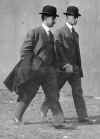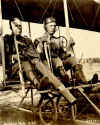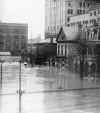 istory is not
especially kind to the Wright brothers where the airplane business is
concerned. It certainly seems they had little to crow about. Their
aircraft company did not prosper; it struggled along for six hard years
until it was finally sold. During that time, it lost it's technological
lead and Wright airplanes became hopelessly obsolete. The brothers
alienated much of the aviation community with their patent law suits.
Then, when they won those suits, Orville alienated the investors in the
Wright Company by refusing to take advantage of their legal position.
Consequently, many historians judge Wilbur and Orville Wright to be as
inept in business as they were brilliant in engineering. istory is not
especially kind to the Wright brothers where the airplane business is
concerned. It certainly seems they had little to crow about. Their
aircraft company did not prosper; it struggled along for six hard years
until it was finally sold. During that time, it lost it's technological
lead and Wright airplanes became hopelessly obsolete. The brothers
alienated much of the aviation community with their patent law suits.
Then, when they won those suits, Orville alienated the investors in the
Wright Company by refusing to take advantage of their legal position.
Consequently, many historians judge Wilbur and Orville Wright to be as
inept in business as they were brilliant in engineering.
But this is simply not true. It's akin to "Monday-morning
quarterbacking." It's very easy to look back and make pronouncements
about what action might have saved the day once the game is played out.
But things look very different when you're on the playing field, the clock
is running, and you have no idea what fate is going to throw at you next.
Our understanding of their business problems is colored by a century of
aviation history. Today the aerospace industry is the largest sector of
the world economy. Much of our culture revolves around flight; we cannot
imagine functioning without airplanes. We forget that it wasn't that way
when the Wright brothers started making flying machines. In 1909, there
was no market for airplanes and most of the world could do very nicely
without those noisy contraptions, thank you very much.
No one was more surprised to find this out than the Wright brothers.
But when the world did not beat a path to their door, they did what they
had always done -- they put their shoulder to the work at hand. They had
invented the airplane; now it was time to help invent the airplane
business.
|
Click on a
photo to enlarge it.

The assembly room at the Wright Company.

The Wright Flying School at Simms Station (old
Huffman Prairie) shot from the air.

A Wright Model AB banking over Simms Station.

Flying at an exhibition in Milwaukee.

A wrecked Wright Model C in College Park, 1912.
|
Timeline:
- The Wright brothers are
approached by a representative of several New York financiers wanting to
invest in aviation, including J.P. Morgan and Cornelius Vanderbilt.
Within a few weeks they reach an agreement and form the Wright Company
with capitalization of $1 million. Wilbur and Orville receive $100,000
and a third of the shares of stock. Suddenly, they are in the airplane
production business.
Fall 1909 - The Wright brothers train
their first crop of student pilots. In accordance with their Army
contract, Wilbur trains the first military pilots at College Park,
Maryland - Lieutenants Frank Lahm, Frederick
Humphreys, and Benjamin Foulois.
Throughout 1910 - The Wrights win an
injunction against the Herring-Curtiss Company, prohibiting the
manufacture, sale, and exhibition of airplanes while the patent suit is
pending. Curtiss files an appeal and keeps flying. Meanwhile, the Wrights
file suits against other American manufacturers, importers of airplanes,
and foreign pilots doing exhibition flights in America. In France and
Germany, the Wright-affiliated companies cross legal swords with European
airplane manufacturers that are using Wright technology. The Patent Wars
are joined on all fronts, with the Wrights against much of the world’s
aviation community. The suits make them many enemies and monopolize their
time.
Spring and Summer 1910 - Aware that
there is more money to be made in exhibition flying than selling
airplanes, the Wright Company decides to field and exhibition team, the
"Wright Fliers." They hire Roy Knabenshue to lead it. They also
put him in charge of the fledgling Wright Flying School, although Orville
trains the first group of pilots, including Walter Brookins, Arch Hoxsey,
A.L. Welsh, Frank Coffyn, Ralph Johnstone, and Phil Parmalee -
all of whom went on to become well-known pioneer aviators. Because the
weather is too cold to fly in Ohio, Orville opens a school in Montgomery,
Alabama and began training on March 28. On June 13 through 18, the Wright
Fliers make their first appearance at the Indianapolis Motor Speedway.
Summer 1910 - The first order of
business for the manufacturing side of the Wright Company was to develop a
new model that incorporated the latest aeronautical developments.
Airplanes had changed quite a bit since the Wright first designed the
Model A in 1907. To improve stability and handling, the Wrights did away
with their distinctive front canard and mounted a flexible elevator behind
the rudder. With a new 40-horsepower 4-cyclinder engine, Wright airplanes
could dispense with the cumbersome launching derrick, so they put wheels
on the landing skids. Orville first flew the improved "Model B"
in July. This was to be the Wright’s most popular airplane.
October 1910 - The Wrights brought
their new Model B to the first international air show to be held in
the United States, at Belmont, New York. They also unveiled a single-seat,
clipped-wing version they called the Model R -
the "R" was for "racer". With a powerful V-8 engine,
it could fly in excess of 70 miles per hour and with it, the Wrights hoped
to snatch the Gordon Bennet trophy for speed away from Curtiss . It wasn’t
to be. Walter Brookins crashed the Model R in a trial flight, and the
trophy went to English pilot Claude Graham-White. This marked the end of
the Wright’s perceived technological superiority in airplane design.
Summer 1910 to Summer 1911 - The Army
and Navy take the first steps to turn the airplane into a weapon. In
August, Lieutenant Jacob Fickel fires a rifle from a Curtiss, proving that
the recoil from the rifle will not effect the aircraft in flight. Later
that same month, James McCurdy uses a wireless transmitter in an aircraft.
In November, Eugene Ely takes off from a makeshift platform built aboard
the U.S.S. Birmingham, marking the beginning of the aircraft carrier. In
January 1911, Lieutenant M. S. Crissy drops live bombs from a Wright
biplane. Later that same year, a Nieuport becomes the first airplane
equipped with a machine gun. Captain Carlo Piazza flies a Bleriot on a
scouting mission for the Italian Army who is fighting the Turks near
Tripoli. It is the first use of an aircraft in a war.
Fall 1911 - Although the armies of the
world were re-inventing the airplane as a weapon, the Wrights still
believed in its use for sport. While Wilbur was in Europe, checking the
French and German factories, Orville made a new glider, his first in
almost a decade, and incorporated all the aerodynamic knowledge they had
gleaned in that time. With his brother Lorin and English pilot Alec
Ogilvie, they traveled to Kitty Hawk, North Carolina to test a glider and
an autopilot system they had been working on since 1906. Once in Kitty
Hawk, Orville decided not to try the automatic pilot because of all the
reporters snooping around, but he did fly the glider, making the world’s
first true soaring flights. On October 24, he remained airborne in the
glider for 9 minutes and 45 seconds, a soaring record that stood for ten
years.
Fall and Winter 1911 - While Orville
was setting a soaring record at Kitty Hawk, a student of his was setting
an endurance record of a different sort. Taking off from Sheepshead Bay on
September 17, Cal Rodgers flew his Wright Model EX, dubbed the Vin Fiz,
westward in a race to be the first to cross the continent in an airplane.
If he arrived at the Pacific Coast in less than 30 days, he would win a
$50,000 purse the publisher William Randolph Hearst put up. Rodgers did
not capture the purse, but his did make it to Long Beach, California 84
days later after five major crashes and countless minor mishaps. Still he
was the first person to cross America - or any
continent - in an airplane.
Winter 1911 to Spring 1912 - The Wright
Company in particular and American airplane companies in general continue
to lose their technological edge to the Europeans. This is due in part to
the U.S. Government’s failure to support the fledgling airplane
industry. While the governments of England, France, and Germany are buying
hundreds of airplanes for their armed forces and supporting aviation
research, the United States is spending roughly the same amount of money
as Bulgaria. At the Wright Company, this crisis is compounded by the fact
that the research and development team - Wilbur
and Orville - is preoccupied with business
matters. Wilbur runs himself ragged over the patent suits and, in his
weakened condition, contracts typhoid. He dies on May 30, 1912.
Summer 1912 to Spring 1913 - Orville
and Katharine take up the gauntlet for Wilbur, pursuing the patent fights
in Germany, France, and the United States. The decisions handed down in
Europe are disappointing. In Germany, the courts rule that although the
Wrights did indeed invent the basic system of aerodynamic control used in
all practical aircraft, they were entitled to only partial protection.
Supposedly, much of their work had been explained in Wilbur’s speeches
and writings before the German patent was issued, and this "prior
disclosure" negated their claim. In France, the ruling is more
favorable for the Wrights, but the defendants filed a motion to have a
panel of experts study "prior art" – inventors who may have
experimented with parts of the Wright control system before they put it
all together. The Wrights lawyers made it clear that the defendants would
be able to stall like this until the French patents ran out. Back in
Dayton, the Wright family faces a disaster of another sort. The city
suffers a devastating flood, and many of the contents of the Wright’s
home and bicycle shop are destroyed. Fortunately, the Wrights early
aeronautical photographs and the stored parts of the 1903 Flyer survive
with only minor damage.
Spring 1913 to Winter 1914 – Patent suits and floods weren’t
the Wright Company’s only problems. A rash of fatal accidents plagued
the new Wright Model C, a more powerful variant of the popular Model B,
and sales plummeted. Orville was convinced the problem lay in the
inexperience of the pilots and perfected an "automatic
stabilizer" – the first primitive autopilot – to prevent
inadvertent stalls and dives. After a convincing demonstration before the
Aero Club of America, Orville was awarded the Collier Trophy for the
invention. It was a triumph for his deceased brother Wilbur, too. The two
of them had worked on the stabilizer off and on as early as 1905. The fall
of 1913 brought the conclusion of another long term project – the Wright
Company successfully tested a flying boat, the Wright Model G. Wilbur and
Orville had experimented with water launches and landings since 1907 and
had flown both the Model B and Model C with pontoons. But Curtiss beat the
Wright Company off the water with the first true flying boat in 1912 and
captured the lion’s share of the United States Navy’s business. To
catch up, Orville hired a promising young engineer, Grover Loening, to
design and build a competitive aeroboat. The turn of the year brought
more good news. On January 13, 1914 the United States Court of Appeals
upheld the Wright brothers 1906 patent and judged it to be the
"grandfather" patent of the airplane.
Throughout 1914 and 1915 – The investors in the Wright Company
push Orville to establish a "patent monopoly" on the airplane, as
Alexander Graham Bell did with the telephone. But Orville balks. Instead
of taking the legal steps to shut other aircraft manufacturers down, he
simply asks them to pay royalties - all except
Curtiss. He will make no deals with Curtiss. At the same time, he begins
to buy up the outstanding shares of the Wright Company. Curtiss,
meanwhile, sees the handwriting on the wall and tries another legal
maneuver. He procurs the wreckage of Langely’s 1903 Great Aerodrome from
the Smithsonian Institution and rebuilds it, making many improvements.
Then he makes a few brief hops, hoping to prove to the courts that while
the Wrights were the first to fly, they were not the first that could have
flown. The Smithsonian embraces this view and thereafter displays the Aerodrome
with a placard that it was the first airplane "capable of
flight." Orville is incensed, and this begins a life-long feud with
the Smithsonian.
Fall 1915 - Orville sells the Wright
Company and his patents to a group of New York investors (several of whom
were the original investors in the company) for $250,000. He is officially
out of the airplane business and rich enough to pursue his own ambitions.
Back to Top |

The incorporation papers for the Wright Company.

Soldiers and students pilots ready a Model A for
launch at College Park in 1909.

Two Curtiss Model Ds in the air over Sheepshead, New
York in 1910.

A 1910 Wright Model B built by a German
manufacturer.

The Wright Flying School in Montgomery, Alabama,
1910.

Orville and his first civilian student pilots in
Alabama.

The Wright Fliers exhibition team in Milwaukee in
1910.

A test flight of a Model A with an elevator attached
to the tail. This was the precursor of the Model B.

The unveiling of the Wright Model B in 1910.

Orville in the 1910 Wright Model R.

The Wright brothers at the Belmont International
Airmeet.

U.S. Army pilots prepare to fire a Lewis machine gun
from a Wright Model B.

Ely flies a Curtiss airplane from a specially-built
deck on a U.S. Navy battleship.

Orville flying an experimental glider during a visit
to Kitty Hawk in 1911.

Cal Rodgers takes off from Sheepshead Bay, New York
on the first flight to cross a continent.

One of Rodgers many crashes enroute.

Cal Rodgers dips the wheels of the Vin Fiz in
the surf at Long Beach, California.

The shape of things to come -- the streamlined
French Deperdussin, the first aircraft to fly over 100 miles per hour.

The 1913 flood in downtown Dayton, Ohio.

Hawthorne Street underwater during the flood.

The missing lower left-hand corner of the first
flight photo is the result of flood damage from 1913.

The wreck of a Wright Model C in College Park,
Maryland.

A Wright Model C with an automatic stabilizer
installed at Huffman Prairie.

A Curtiss Model E flying boat taking off over Lake
Keuka in 1912.

A 1913 Wright Model G takes off from the Great Miami
River.

A Wright Model F with an enclosed fuselage runs up
its engine in front of the hangar at Huffman Prairie in 1914.

The U.S. Army's first "modern" airplane, a
Burgess biplane rebuilt in 1914 to copy advances in European aircraft. The
Wright designs were obsolete.

Curtiss flying the much-modified 1903 Great
Aerodrome over Lake Keuka.

The Wright Model L, the last airplane built by the
Wright Company.
|

